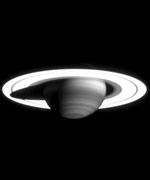
Image credit: NASA/JPL
Wind-blown clouds and hazes high in Saturn’s atmosphere are captured in a movie made from images taken by the Cassini narrow angle camera between Feb. 15 and Feb. 19, 2004. The images were made using a filter sensitive to a narrow range of wavelengths centered at 889 nanometers where methane in Saturn’s atmosphere absorbs sunlight. Cassini was 65.6 million kilometers (40.7 million miles) from Saturn when the images, reduced in size by a factor of two onboard the spacecraft, were taken. The resulting image scale is approximately 786 kilometers (420 miles) per pixel.
This is the first movie ever made showing Saturn in these near-infrared wavelengths. The movie, consisting of 30 stacked images, spans five days and captures five complete but non-consecutive Saturn rotations. The direction of motion is prograde, or left to right. Each 10.6 hour Saturn rotation is evenly sampled by six images. In `movie time’, there is 0.25 second between each of the six images in an individual rotation, and one second between rotations. After each rotation sequence, the planet can be seen to grow slightly in the field of view.
Cassini has three filters designed to sense different heights of clouds and hazes in Saturn’s atmosphere. Any light detected by cameras using the 889 nanometer filter is reflected very high in the atmosphere, before the light is absorbed. Thus, the bright areas in these images represent high hazes and clouds near the top of Saturn’s troposphere.
In the movie, atmospheric motions can be seen most clearly in the equatorial region and at other southern latitudes as well. Saturn’s equatorial region seems disturbed in the same way that it has been for the past decade, as revealed by observations from the Hubble Space Telescope. Researchers have speculated that the bright cloud patterns there are associated with water-moist convection arising from a deeper atmospheric level where water condenses on Saturn, and rising to levels at or above the visible cloud tops. Close analysis of future images by scientists on the Cassini-Huygens mission should help determine if this is the case.
Saturn’s rings are extremely overexposed in these images. Because the range of wavelengths for this spectral filter is narrow, and because most of this light is absorbed by Saturn, the disk of Saturn is inherently faint and the exposures required are quite long (22 seconds). The rings do not strongly absorb at these wavelengths, and so reflect more light and are overexposed compared to the atmosphere. Orbiting moons in the images were manually removed during processing.
The Cassini-Huygens mission is a cooperative project of NASA, the European Space Agency and the Italian Space Agency. The Jet Propulsion Laboratory, a division of the California Institute of Technology in Pasadena, manages the Cassini-Huygens mission for NASA’s Office of Space Science, Washington, D.C. The imaging team is based at the Space Science Institute, Boulder, Colorado.
For more information about the Cassini-Huygens mission, visit http://saturn.jpl.nasa.gov and the Cassini imaging team home page, http://ciclops.org.
Original Source: CICLOPS News Release
